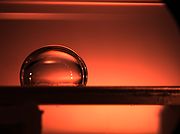
Sessile drop technique
Encyclopedia
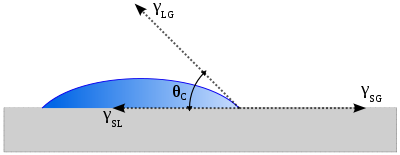
Surface energy
Surface energy quantifies the disruption of intermolecular bonds that occur when a surface is created. In the physics of solids, surfaces must be intrinsically less energetically favorable than the bulk of a material, otherwise there would be a driving force for surfaces to be created, removing...
, and in some cases, aspects of liquid surface energies. The main premise of the method is that by placing a droplet of liquid with a known surface energy, the shape of the drop, specifically the contact angle
Contact angle
The contact angle is the angle at which a liquid/vapor interface meets a solid surface. The contact angle is specific for any given system and is determined by the interactions across the three interfaces. Most often the concept is illustrated with a small liquid droplet resting on a flat...
, and the known surface energy of the liquid are the parameters which can be used to calculate the surface energy of the solid sample. The liquid used for such experiments is referred to as the probe liquid, and the use of several different probe liquids is required.
Probe Liquid
The surface energy is measured in units of Joules per area, which is equivalent in the case of liquids to surface tension, measured in newtons per meter. The overall surface tensionSurface tension
Surface tension is a property of the surface of a liquid that allows it to resist an external force. It is revealed, for example, in floating of some objects on the surface of water, even though they are denser than water, and in the ability of some insects to run on the water surface...
/energy of a liquid can be acquired through various methods using a tensiometer
Tensiometer
A Tensiometer as it applies to physics is an instrument used to measure the surface tension of liquids.-Goniometer/Tensiometer:...
or using the pendent drop technique and Maximum bubble pressure method.
The interface tension at the interface of the probe liquid and the solid surface can additionally be viewed as being the result of different types of intermolecular forces. As such, surface energies can be subdivided according to the various interactions that cause them, such as the surface energy due to dispersive (van der Waals
Van der Waals force
In physical chemistry, the van der Waals force , named after Dutch scientist Johannes Diderik van der Waals, is the sum of the attractive or repulsive forces between molecules other than those due to covalent bonds or to the electrostatic interaction of ions with one another or with neutral...
) forces, hydrogen bonding, polar interactions
Chemical polarity
In chemistry, polarity refers to a separation of electric charge leading to a molecule or its chemical groups having an electric dipole or multipole moment. Polar molecules interact through dipole–dipole intermolecular forces and hydrogen bonds. Molecular polarity is dependent on the difference in...
, acid/base interactions, etc. It is often useful for the sessile drop technique to use liquids that are known to be incapable of some of those interactions (see table 1). For example, the surface tension of all straight alkane
Alkane
Alkanes are chemical compounds that consist only of hydrogen and carbon atoms and are bonded exclusively by single bonds without any cycles...
s is said to be entirely dispersive, and all of the other components are zero. This is algebraically useful, as it eliminates a variable in certain cases, and makes these liquids essential testing materials.
The overall surface energy, both for a solid and a liquid, is assumed traditionally to simply be the sum of the components considered. For example, the equation describing the subdivision of surface energy into the contributions of dispersive interactions and polar interactions would be:
 S =
S =  SD +
SD +  SP
SP L =
L =  LD +
LD +  LP
LPWhere
 S is the total surface energy of the solid,
S is the total surface energy of the solid,  SD and
SD and  SP are respectively the dispersive and polar components of the solid surface energy,
SP are respectively the dispersive and polar components of the solid surface energy, L is the total surface tension/surface energy of the liquid, and
L is the total surface tension/surface energy of the liquid, and LD and
LD and  LP are respectively the dispersive and polar components of the surface tension.
LP are respectively the dispersive and polar components of the surface tension.In addition to the tensiometer and pendant drop techniques, the sessile drop technique can be used in some cases to separate the known total surface energy of a liquid into its components. This is done by reversing the above idea with the introduction of a reference solid surface that is assumed to be incapable of polar interactions, such as Polytetrafluoroethylene
Polytetrafluoroethylene
Polytetrafluoroethylene is a synthetic fluoropolymer of tetrafluoroethylene that finds numerous applications. PTFE is most well known by the DuPont brand name Teflon....
(PTFE).
Contact angle

Wetting
Wetting is the ability of a liquid to maintain contact with a solid surface, resulting from intermolecular interactions when the two are brought together. The degree of wetting is determined by a force balance between adhesive and cohesive forces.Wetting is important in the bonding or adherence of...
.
Goniometer method
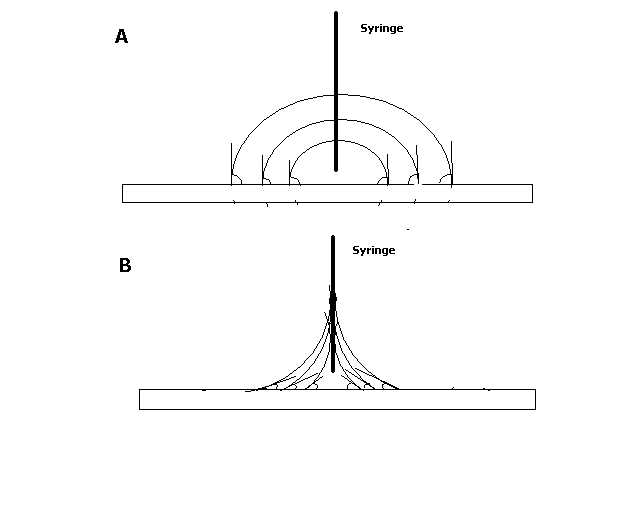
Goniometer
A goniometer is an instrument that either measures an angle or allows an object to be rotated to a precise angular position. The term goniometry is derived from two Greek words, gōnia, meaning angle, and metron, meaning measure....
, which allows the user to measure the contact angle visually. The droplet is deposited by a syringe pointed vertically down onto the sample surface, and a high resolution camera captures the image, which can then be analyzed either by eye (with a protractor) or using image analysis software. The size of the droplet can be increased gradually so that it grows proportionally, and the contact angle remains congruent. By taking pictures incrementally as the droplet grows, the user can acquire a set of data to get a good average. If necessary, the receding contact angle can also be measured by depositing a droplet via syringe and recording images of the droplet being gradually sucked back up.
Advantages and disadvantages
The advantage of this method, aside from its relatively straightforward nature, is the fact that with a large enough solid surface, multiple droplet can be deposited in various locations on the sample to determine heterogeneity. The reproducibility of particular values of the contact angle will reflect the heterogeneity of the surface’s energy properties. Conversely, the disadvantage is that if the sample is only large enough for one droplet, then it will be difficult to determine heterogeneity, or consequently to assume homogeneity. This is particularly true because conventional, commercially available goniometers do not swivel the camera/backlight set up relative to the stage, and thus can only show the contact angle at two points: the right and the left edge of the droplet. In addition to this, this measurement is hampered by its inherent subjectivity, as the placement of the lines is determined either by the user looking at the pictures or by the image analysis software’s definition of the lines.
Wilhelmy methodWilhelmy plateA Wilhelmy plate is a thin plate that is used to measure equilibrium surface or interfacial tension at an air–liquid or liquid–liquid interface. In this method, the plate is oriented perpendicular to the interface, and the force exerted on it is measured...
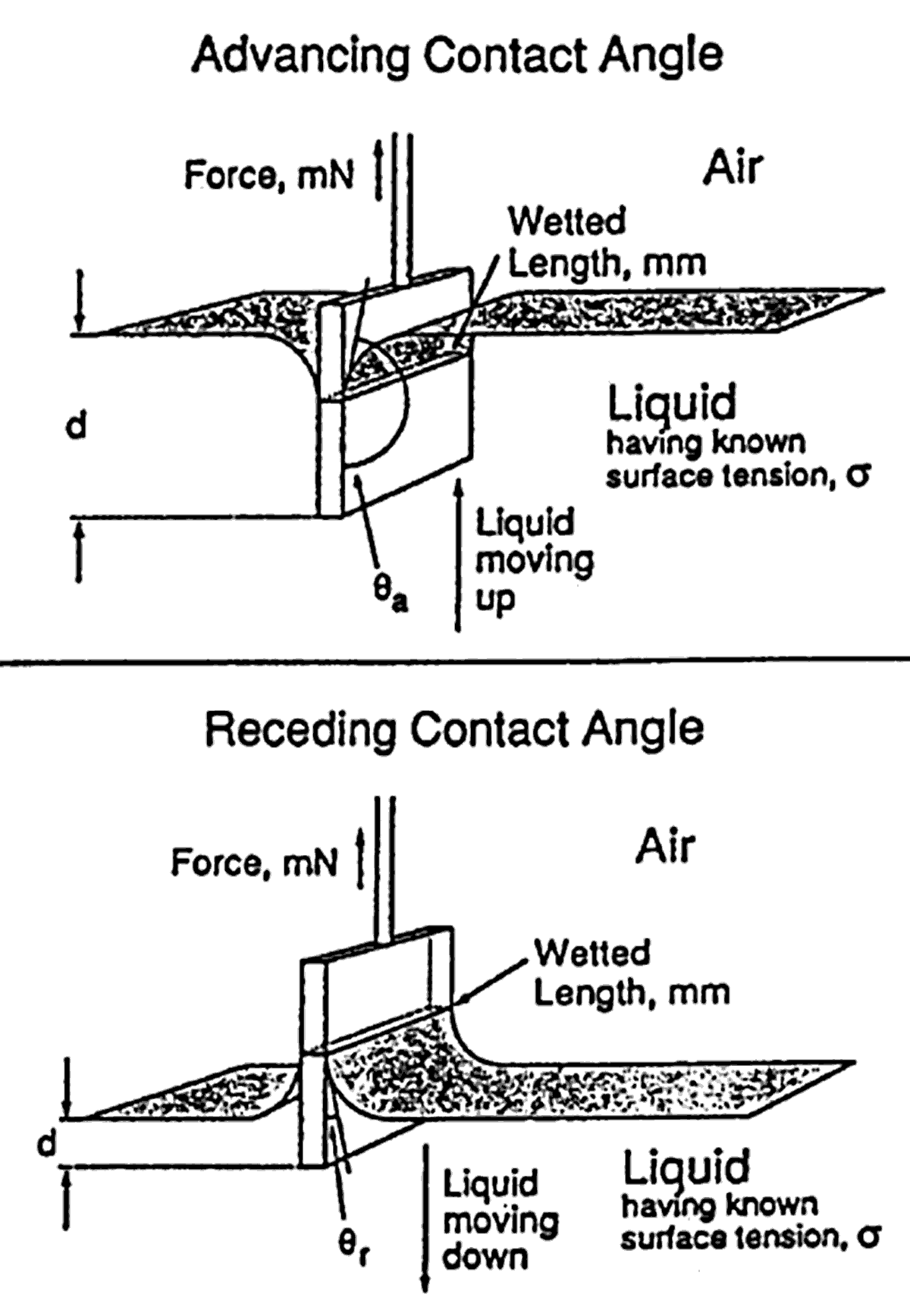

Where F is the total force measured by the force meter, Fb is the force of buoyancy due to the solid sample displacing the liquid, I is the wetted length, and sigma is the known surface tension of the liquid.
Advantages and disadvantages
The advantage of this method is that it is fairly objective and the measurement yields data which is inherently averaged over the wetted length. Although this does not help determine heterogeneity, it does automatically give a more accurate average value. Its disadvantages, aside from being more complicated than the goniometer method, include the fact that sample of an appropriate size must be produced with a uniform cross section in the submersion direction, and the wetted length must be measured with some precision. In addition, this method is only appropriate if both sides of the sample are identical, otherwise the measured data will be a result of two completely different interactions.
Strictly speaking, this is not a sessile drop technique, as we are using a small submerging pool, rather than a droplet. However, the calculations described in the following sections, which were derived for the relation of the sessile drop contact angle to the surface energy, apply just as well.
Determining Surface Energy
While surface energySurface energy
Surface energy quantifies the disruption of intermolecular bonds that occur when a surface is created. In the physics of solids, surfaces must be intrinsically less energetically favorable than the bulk of a material, otherwise there would be a driving force for surfaces to be created, removing...
is conventionally defined as the work required to build a unit of area of a given surface, when it comes to its measurement by the sessile drop technique, the surface energy is not quite as well defined. The values obtained through the sessile drop technique depend not only on the solid sample in question, but equally on the properties of the probe liquid being used, as well as the particular theory relating the parameters mathematically to one another.
There are numerous such theories developed by various researchers. These methods differ in several regards, such as derivation and convention, but most importantly they differ in the number of components or parameters which they are equipped to analyze. The simpler methods containing fewer components simplify the system by lumping surface energy into one number, while more rigorous methods with more components are derived to distinguish between various components of the surface energy. Again, the total surface energy of solids and liquids depends on different types of molecular interactions, such as dispersive (van der Waals), polar, and acid/base interactions, and is considered to be the sum of these independent components. Some theories account for more of these phenomena than do other theories. These distinctions are to be considered when deciding which method is appropriate for the experiment at hand. The following are a few commonly used such theories.
The Zisman Theory
The ZismanWilliam Zisman
Dr. William Albert Zisman was an American chemist and geophysicist.He was born in Albany, NY and spent his youth in Providence, RI up to the age of 14 when his family moved to Washington, DC. He earned his BS and MS degrees in physics from Massachusetts Institute of Technology. He began his career...
theory is the simplest commonly used theory, as it is a one component theory, and is best used for non-polar surfaces. This means that polymer surfaces that have been subjected to heat treatment
Heat treatment
Heat treating is a group of industrial and metalworking processes used to alter the physical, and sometimes chemical, properties of a material. The most common application is metallurgical. Heat treatments are also used in the manufacture of many other materials, such as glass...
, corona treatment
Corona treatment
Corona treatment is a surface modification technique that uses a low temperature corona discharge plasma to impart changes in the properties of a surface. The corona plasma is generated by the application of high voltage to sharp electrode tips which forms plasma at the ends of the sharp tips...
, plasma cleaning
Plasma cleaning
Plasma cleaning involves the removal of impurities and contaminants from surfaces through the use of an energetic plasma created from gaseous species. Gases such as argon and oxygen, as well as mixtures such as air and hydrogen/nitrogen are used...
, or polymers that contain heteroatoms do not lend themselves to this particular theory, as they tend to be at least somewhat polar
Chemical polarity
In chemistry, polarity refers to a separation of electric charge leading to a molecule or its chemical groups having an electric dipole or multipole moment. Polar molecules interact through dipole–dipole intermolecular forces and hydrogen bonds. Molecular polarity is dependent on the difference in...
. The Zisman theory also tends to be more useful in practice for surfaces with lower energies.
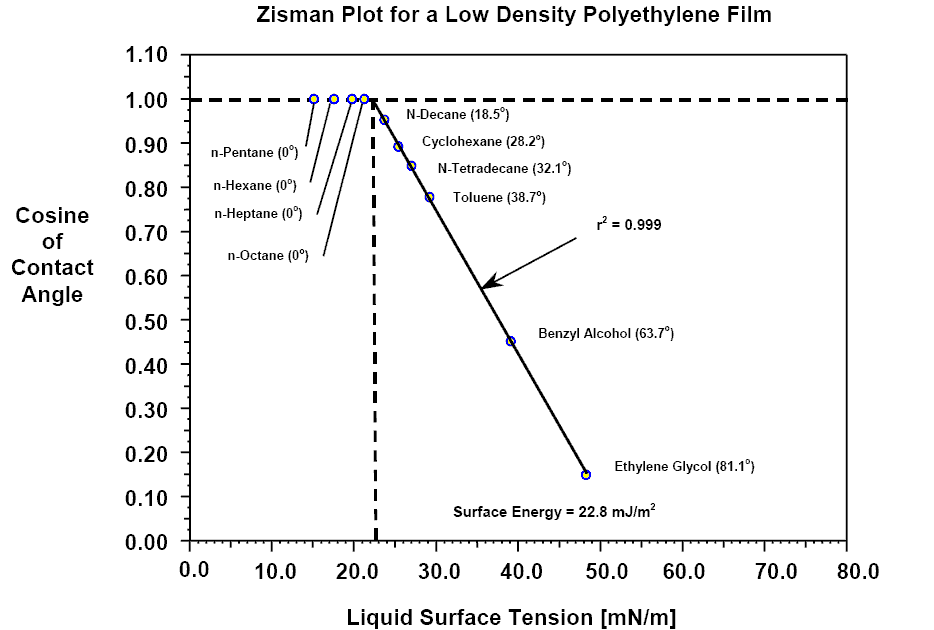
Accuracy/precision
The line coefficient (Fig 5) suggests that this is a fairly accurate result, however this is only the case for the pairing of that particular solid with those particular liquids. In other cases, the fit may not be so great (such is the case if we replace polyethylene with poly(methyl methacrylate), wherein the line coefficient of the plot results using the same list of liquids would be significantly lower). This shortcoming is a result of the fact that the Zisman theory treats the surface energy as one single parameter, rather than accounting for the fact that, for example, polar interactions are much stronger than dispersive ones, and thus the degree to which one is happening versus the other greatly affects the necessary calculations. As such, it is a simple but not particularly robust theory. Since the premise of this procedure is to determine the hypothetical properties of a liquid, the precision of the result depends on the precision to which the surface energy values of the probe liquids are known.
The Owens/Wendt Theory
The Owens/Wendt theory (after C. J. van Oss and John F. Wendt) divides the surface energy into two components: surface energy due to dispersive interactions and surface energy due to polar interactions. This theory is derived from the combination of Young's relationWetting
Wetting is the ability of a liquid to maintain contact with a solid surface, resulting from intermolecular interactions when the two are brought together. The degree of wetting is determined by a force balance between adhesive and cohesive forces.Wetting is important in the bonding or adherence of...
, which relates the contact angle to the surface energies of the solid and liquid and to the interface tension, and Good’s equation (after R. J. Good), which relates the interface tension to the polar and dispersive components of the surface energy. The resulting principle equation is:
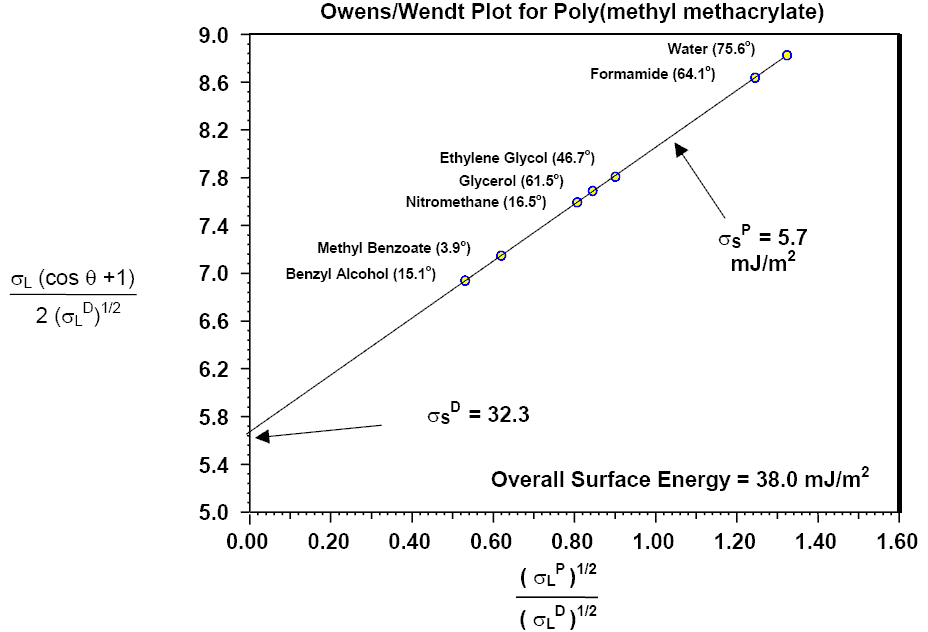
 =
=  +
+ 
Note that this equation has the form of y=mx+b, with:
y =
 ; m =
; m =  ; x =
; x =  ; b =
; b = 
As such, the polar and dispersive components of the solid’s surface energy are determined by the slope and intercept of the resulting graph. Of course, the problem at this point is that in order to make that graph, knowing the surface energy of the probe liquid is not enough, as it is necessary to know specifically how it breaks down into its polar and dispersive components as well.
To do this, one can simply reverse the procedure by testing the probe liquid against a standard reference solid that is not capable of polar interactions, such as PTFE. If the contact angle of a sessile drop of the probe liquid is measured on a PTFE surface, the principle equation reduces to:
 =
= 
Since the total surface tension of the liquid is already known, this equation determines the dispersive component, and the difference between the total and dispersive components gives the polar component.
Accuracy/precision
The accuracy and precision of this method is supported largely by the confidence level of the results for appropriate liquid/solid combinations (as seen, for example, in fig 6). The Owens/Wendt theory is typically applicable to surfaces with low charge and moderate polarity. Some good examples are polymers that contain heteroatoms, such as PVC
PVC
Polyvinyl chloride is a plastic.PVC may also refer to:*Param Vir Chakra, India's highest military honor*Peripheral venous catheter, a small, flexible tube placed into a peripheral vein in order to administer medication or fluids...
, polyurethanes, polyamides, polyesters, polyacrylates, and polycarbonates
The Fowkes Theory
The Fowkes theory (after F. M. Fowkes) is derived in a slightly different way from the Owens/Wendt theory, although the Fowkes theory’s principle equation is mathematically equivalent to that of Owens and Wendt: =
=  +
+ 
Note that by dividing both sides of the equation by
 , the Owens/Wendt principle equation is recovered. As such, one of the options for the proper determination of the surface energy components is the same.
, the Owens/Wendt principle equation is recovered. As such, one of the options for the proper determination of the surface energy components is the same.In addition to that method, it is also possible to simply do tests using liquids with no polar component to their surface energies, and then liquids that do have both polar and dispersive components, and then linearize the equations (see table 1). First, one performs the standard sessile drop contact angle measurement for the solid in question and a liquid with a polar components of zero (
 =0;
=0;  =
= ) The second step is to use a second probe liquid that has both a dispersive and a polar component to its surface energy, and then solve for the unknowns algebraically. The Fowkes theory generally requires the use of only two probe liquids, as described above, and the recommended ones are diiodomethane
) The second step is to use a second probe liquid that has both a dispersive and a polar component to its surface energy, and then solve for the unknowns algebraically. The Fowkes theory generally requires the use of only two probe liquids, as described above, and the recommended ones are diiodomethaneDiiodomethane
Diiodomethane or methylene iodide, commonly abbreviated "MI", is a liquid organoiodine compound. It is insoluble in water, but soluble in ether and alcohol. It has a relatively high refractive index of 1.741, and a surface tension of 0.0508 N·m−1...
, which should have no polar component due to its molecular symmetry, and water
Water
Water is a chemical substance with the chemical formula H2O. A water molecule contains one oxygen and two hydrogen atoms connected by covalent bonds. Water is a liquid at ambient conditions, but it often co-exists on Earth with its solid state, ice, and gaseous state . Water also exists in a...
, which is commonly known to be a very polar liquid.
Accuracy/precision
Though the principle equation is essentially identical to that of Owens and Wendt, the Fowkes theory in a larger sense has slightly different applications. Because it is derived from different principles than Owens/Wendt, the rest of the information that Fowkes theory is concerned with is related to adhesion
Adhesion
Adhesion is any attraction process between dissimilar molecular species that can potentially bring them in close contact. By contrast, cohesion takes place between similar molecules....
. As such, it is more applicable to situations where adhesion occurs, and in general works better than does the Owens/Wendt theory when dealing with higher surface energies.
In addition, there is an extended Fowkes theory, rooted in the same principles, but dividing the total surface energy into a sum of three rather than two components: surface energy due to dispersive interactions, polar interactions, and hydrogen bonding.
The Wu Theory
The Wu theory (after Guo Xiong Wu) is also essentially similar to the Owens/Wendt and Fowkes theories, in that it divides surface energy into a polar and a dispersive component. The primary difference is that Wu uses the harmonic meanHarmonic mean
In mathematics, the harmonic mean is one of several kinds of average. Typically, it is appropriate for situations when the average of rates is desired....
s rather than the geometric mean
Geometric mean
The geometric mean, in mathematics, is a type of mean or average, which indicates the central tendency or typical value of a set of numbers. It is similar to the arithmetic mean, except that the numbers are multiplied and then the nth root of the resulting product is taken.For instance, the...
s of the known surface tensions, and subsequently the use of more rigorous mathematics is employed.
Accuracy/precision
The Wu theory provides more accurate results than do the other two component theories, particularly for high surface energies. It does, however, suffer from one complication: because of the mathematics involved, the Wu theory yields two results for each component, one being the true result, and one being simply a consequence of the mathematics. The challenge at this point lies in interpreting which is the true result. Sometimes this is as simple as eliminating the result that makes no physical sense (a negative surface energy) or the result that is clearly incorrect by virtue of being many orders of magnitude larger or smaller than it should be. Sometimes interpretation is more tricky.
The Schultz Theory
The Schultz theory (after D. L. Schultz) is applicable only for very high energy solids. Again, it is similar to the theories of Owens, Wendt, Fowkes, and Wu, but is designed for a situation where conventional measurement required for those theories is impossible. In the class of solids with sufficiently high surface energy, most liquids wet the surface completely with a contact angle of zero degrees, and thus no useful data can be gathered. The Schultz theory and procedure calls to deposit a sessile drop of probe liquid on the solid surface in question, but this is all done while the system is submerged in yet another liquid, rather than being done in the open air. As a result, the higher “atmospheric” pressure due to the surrounding liquid causes the probe liquid droplet to compress so that there is a measurable contact angle.Accuracy/precision
This method is designed to be robust where the other methods don’t even provide any results in particular. As such, it is indispensable, since it is the only way to use the sessile drop technique on very high surface energy solids. Its major drawback is the fact that it is far more complex, both in its mathematics and experimentally. The Schultz theory requires one to account for many more factors, as there is now the unusual interaction of the probe liquid phase with the surrounding liquid phase. In addition, the set up of the camera and backlight become more complicated owing to the refractive properties of the surrounding liquid, not to mention the set up of the two-liquid system itself.
The van Oss Theory
The van Oss theory separates the surface energy of solids and liquids into three components. It includes the dispersive surface energy, as before, and subdivides the polar component as being the sum of two more specific components: the surface energy due to acidic interactions ( ) and due to basic interactions (
) and due to basic interactions ( ). The acid component theoretically describes a surface’s propensity to have polar interactions with a second surface that has the ability to act basic by donating electrons. Conversely, the base component of the surface energy describes the propensity of a surface to have polar interactions with another surface that acts acidic by accepting electrons. The principle equation for this theory is:
). The acid component theoretically describes a surface’s propensity to have polar interactions with a second surface that has the ability to act basic by donating electrons. Conversely, the base component of the surface energy describes the propensity of a surface to have polar interactions with another surface that acts acidic by accepting electrons. The principle equation for this theory is: =
= 
Again, the best way to deal with this theory, much like the two component theories, is to use at least three liquids (more can be used to get more results for statistical purposes) – one with only a dispersive component to its surface energy (
 ), one with only a dispersive and an acidic or basic component (
), one with only a dispersive and an acidic or basic component ( ), and finally either a liquid with a dispersive and a basic or acidic component (whichever the second probe liquid did not have (
), and finally either a liquid with a dispersive and a basic or acidic component (whichever the second probe liquid did not have ( )), or a liquid with all three components (
)), or a liquid with all three components ( ) – and linearizing the results.
) – and linearizing the results.Accuracy/precision
Being a three component theory, it is naturally more robust than other theories, particularly in cases where there is a great imbalance between the acid and base components of the polar surface energy. The van Oss theory is most suitable for testing the surface energies of inorganics, organometallics, and surface containing ions.
The most significant difficulty of applying the van Oss theory is the fact that there is not much of an agreement in regards to a set of reference solids that can be used to characterize the acid and base components of potential probe liquids. There are however some liquids that are generally agreed to have known dispersive/acid/base components to their surface energies. Two of them are listed in table 1.
Table 1
| Liquid | Total Surface Tension (mN/m) | Dispersive Component (mN/m) | Polar Component (mN/m) | Acid Component (mN/m) | Base Component (mN/m) |
|---|---|---|---|---|---|
| Diiodomethane Diiodomethane Diiodomethane or methylene iodide, commonly abbreviated "MI", is a liquid organoiodine compound. It is insoluble in water, but soluble in ether and alcohol. It has a relatively high refractive index of 1.741, and a surface tension of 0.0508 N·m−1... |
50.8 | 50.8 | 0 | 0 | 0 |
| Water Water Water is a chemical substance with the chemical formula H2O. A water molecule contains one oxygen and two hydrogen atoms connected by covalent bonds. Water is a liquid at ambient conditions, but it often co-exists on Earth with its solid state, ice, and gaseous state . Water also exists in a... |
72.8 | 26.4 | 46.4 | 23.2 | 23.2 |
Potential problems
The presence of surface active elements such as oxygen and sulphur will have a large impact on the measurements obtained with this technique. Surface active elements will exist in larger concentrations at the surface than in the bulk of the liquid, meaning that the total levels of these elements must be carefully controlled to a very low level. For example, the presence of only 50 ppm sulphur in liquid iron will reduce the surface tension by approximately 20%.Practical applications
The sessile drop technique has various applications for both materials engineering and straight characterization. In general, it is useful in determining the surface tension of liquids through the use of reference solids. There are various other specific applications which can be subdivided according to which of the above theories is most likely to be applicable to the circumstances:The Zisman theory is mostly used for low energy surfaces and characterizes only the total surface energy. As such, it is probably most useful in cases that recall the conventional definition of surfaces, for example if a chemical engineer wants to know what the energy associated with fabricating a surface is. It may also be useful in cases where the surface energy has some effect on a spectroscopic technique being used on the solid in question.
The two component theories would most likely be applicable to materials engineering questions about the practical interactions of liquids and solids. The Fowkes theory, since it is more suited for higher energy solid surfaces, and since much of it is rooted in theories about adhesion
Adhesion
Adhesion is any attraction process between dissimilar molecular species that can potentially bring them in close contact. By contrast, cohesion takes place between similar molecules....
, would likely be suited for the characterization of interactions where the solids and liquids have a high affinity for one another, such as, logically enough, adhesives and adhesive coatings. The Owens/Wendt theory, which deals in low energy solid surfaces, would be helpful in characterizing the interactions where the solids and liquids do not have a strong affinity for one another – for example, the effectiveness of waterproofing
Waterproofing
Waterproof or water-resistant describes objects relatively unaffected by water or resisting the ingress of water under specified conditions. Such items may be used in wet environments or under water to specified depths...
. Polyurethanes and PVC are good examples of waterproof plastics.
The Schultz theory is best used for the characterization of very high energy surfaces for which the other theories are ineffective, the most significant example being bare metals.
The van Oss theory is most suitable for cases in which acid/base interaction is an important consideration. Examples include pigments, pharmaceuticals, and paper
Paper
Paper is a thin material mainly used for writing upon, printing upon, drawing or for packaging. It is produced by pressing together moist fibers, typically cellulose pulp derived from wood, rags or grasses, and drying them into flexible sheets....
. Specifically, notable examples include both paper used for the regular purpose of printing, and the more specialized case of litmus paper, which in itself is used to characterize acidity and basicity.
See also
- Surface energySurface energySurface energy quantifies the disruption of intermolecular bonds that occur when a surface is created. In the physics of solids, surfaces must be intrinsically less energetically favorable than the bulk of a material, otherwise there would be a driving force for surfaces to be created, removing...
- goniometerGoniometerA goniometer is an instrument that either measures an angle or allows an object to be rotated to a precise angular position. The term goniometry is derived from two Greek words, gōnia, meaning angle, and metron, meaning measure....
- contact angleContact angleThe contact angle is the angle at which a liquid/vapor interface meets a solid surface. The contact angle is specific for any given system and is determined by the interactions across the three interfaces. Most often the concept is illustrated with a small liquid droplet resting on a flat...
- Wilhelmy plateWilhelmy plateA Wilhelmy plate is a thin plate that is used to measure equilibrium surface or interfacial tension at an air–liquid or liquid–liquid interface. In this method, the plate is oriented perpendicular to the interface, and the force exerted on it is measured...
- Du Noüy ring methodDu Noüy ring methodThe du Noüy ring method is one technique by which the surface tension of a liquid can be measured. The method involves slowly lifting a ring, often made of platinum, from the surface of a liquid...


